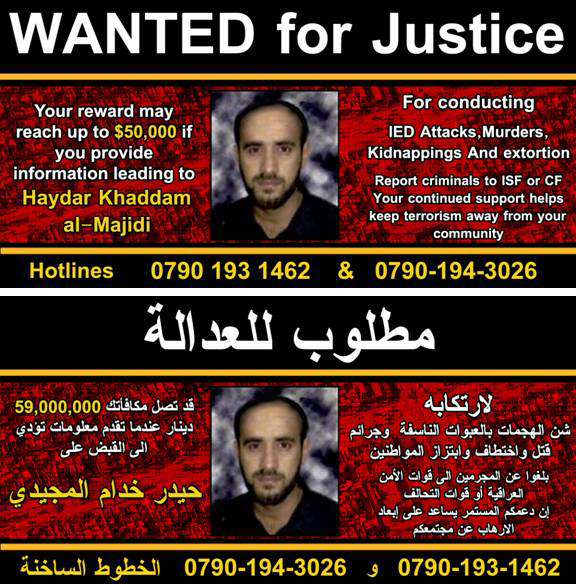The Hurriya Bombing

The June bombing took place in northwestern Baghdad’s Hurriya district. The U.S. military blamed the attack on a breakaway Special Groups faction of Sadr’s Jaish al Mahdi (JAM) militia. Special Groups is the term used by the Coalition for elements of Sadr’s movement that are supported by Iran and may or may not be under his control. An American military spokesman said the aim of the bombing was to stop the return of Sunnis who had been forced out during the battle for the capital in 2006-2007 and to provoke sectarian fighting. The car bomb was the largest in Baghdad in three months.
 Wanted poster of Special Groups commander, Haydar Mahdi Khadum al-Fawadi, who the U.S. says is responsible for the Hurriya bombing
Wanted poster of Special Groups commander, Haydar Mahdi Khadum al-Fawadi, who the U.S. says is responsible for the Hurriya bombingHurriya was a traditionally mixed area with a Shiite majority. In 2006, Hurriya became a battlefield between Sunnis and Shiites. Insurgents launched attacks while Sadr’s militia moved in. JAM systematically divided up the area and expelled the Sunni fighters and families, assisted by the local police. The Mahdi Army then used Hurriya as a launching pad for attacks on neighboring districts, while giving safe haven to Shiites that were themselves being displaced from other parts of Baghdad. By November 2006 the Sadrists were firmly in control.
When the surge started in 2007 many of the JAM leaders fled the area or were arrested turning it over to younger, less experienced commanders and criminals who alienated the community. The change in leadership created a division within the militia, which led to attacks upon each other, and a battle over the spoils of their newly won neighborhood.
Sadr does not pay his followers, so militia members must support themselves through pay offs, running gas and oil stations, and renting out former Sunni homes to Shiites. (The U.S. claimed the bombing for example, was meant to keep Sunnis from returning so that the militia might continue to control their property.)
Desperate Times?
After rising to be the most powerful Shiite militia during the battle for Baghdad, Sadr’s followers now find themselves on the defensive. Beginning in March 2008 Prime Minister Nouri al-Maliki has made a concerted effort to break the back of JAM to prove that he is the true leader of Iraq, capable of securing his own country, while destroying his main political rival Muqtada al-Sadr. With operations in Basra, Sadr City in Baghdad, and now Maysan province, government forces have rounded up and killed hundreds of Mahdi members. Maliki has also threatened to bar the Sadrists from competing in upcoming provincial elections if they do not disarm. The Prime Minister’s actions have been supported by most political factions in Iraq, and even by Iran at times.
Sadr and his advisors appear to be divided about how to respond to their predicament. There are some that want to move away from the gun and focus upon politics, while others are pushing for revenge against Maliki and U.S. forces. The Hurriya attack comes out of this period of flux in Iraqi society. The government is cracking down on its main opponents, while the Sadrists haven’t formulated a clear response. The bombing then, can be seen as an act of desperation by JAM members to maintain their hold on their fief, while attempting to bring back the “good old days” of the sectarian war of 2006-2007 when the Mahdi Army was seen as holding an AK in one hand to protect the Shiites, while taking their money in the other. Their rash actions however will only bring down the boot of the government and Coalition forces that much harder upon them, while alienating the public which they depend upon.
Sources
Adas, Basil, “Al Sadr followers consider Al Maliki a mortal enemy,” Gulf News, 4/2/08
- “Militia break-up poses questions,” Gulf News, 4/15/08
Agence France Presse, “Shiites behind Baghdad bombing: US,” 6/18/08
Associated Press, “Shiite militia may be disintegrating,” 3/21/07
Al-Gharafi, Abdulhussein, “Sadr’s Mahdi Army refuses to disarm,” Azzaman, 4/7/08
Glanz, James and Farrell, Stephen, “Crackdown on Militias Raises Stability Concerns,” New York Times, 4/8/08
Hendawi, Hamza and Abdul-Zahra, Qassim, “Al-Sadr shift: away from politics and favoring fight,” Associated Press, 4/24/08
International Crisis Group, “Iraq’s Civil War, The Sadrists And The Surge,” 2/7/08
Morning Edition, “Assessing Iraq’s Security Forces,” National Public Radio, 4/10/08
Parker, Ned, “Iraqi civilian deaths plunge,” Los Angeles Times, 11/1/07
Roggio, Bill, “Iraqi security forces ramp up for Maysan operation,” Long War Journal.org, 6/17/08
Rubin, Alissa, “Sadrists and Iraqi Government Reach Truce Deal,” New York Times, 5/11/08
Susman, Tina, “Can Iraq’s soldiers fight?” Los Angeles Times, 4/3/08
Westervelt, Eric, “Iraqis Skeptical New Sense of Security Can Last,” All Things Considered – NPR, 11/1/07




No comments:
Post a Comment